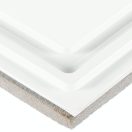The Challenge
The University of Maryland Marlene and Stewart Greenebaum Comprehensive Cancer Center (UMGCCC) provides outpatient care for cancer patients in a 25,000 SF state-of-the-art facility named the Roslyn and Leonard Stoler Pavilion
The infusion/chemotherapy treatment portion of the Stoler Pavilion is an extension of the main lobby of the University of Maryland Medical Center (UMMC) with large floor-to-ceiling storefront windows, 10-foot ceilings, and a metal pan deck that is 10 feet above the uninsulated drop ceiling. The heating and air conditioning consisted of digitally controlled Variable Air Volume (VAV) boxes with reheat coils and baseboard heat.
For years the facilities staff received hot calls in the summer and cold calls in the winter. The facilities staff would adjust the discharge temperature of the central air handlers to push colder air to the space, they would adjust the setpoints of the space, and they even closed dampers elsewhere on the floor to push more volume to the space. No matter what adjustments they made to the heating and air conditioning system, the patients, staff, and visitors were never satisfied. The cancer patients in the infusion area wear thin gowns and sit next to the perimeter windows for 8-10 hours a day and some receive treatment multiple times a week.
The Solution
In the summer of 2018, the Director of Operations and Maintenance learned about Phase Change Material (PCM) heat storage at the Better Buildings Summit in Cleveland, OH. After learning about this technology, UMMC decided to try PCM in the ceilings to help address the temperature swings experienced in the Stoler Pavilion. The solution was chosen because it was Class A plenum fire rated and stored 100 BTUs per square foot.
After discussing the application with product engineers, PCM material was added to the ceiling over approximately 70% of the space. The temperatures above and below the ceiling in two separate locations of the Stoler Pavilion were recorded for two weeks prior to the installation to prove the efficacy of the material.
In October 2018, ten UMMC facilities team members installed the material in just over two hours. Prior to the installation, the UMMC facilities team was receiving an average of 2.58 hot/cold complaints per month from the Stoler Pavilion. Since the installation, the hot/cold complaints have reduced to zero.
The installation was focused on patient and staff satisfaction, so energy use wasn’t recorded or measured, but the UMMC team has calculated that energy savings are likely to be 1,500 to 2,000 kWh per month, yielding a very short payback in roughly 3 to 5 years, considering both energy and facilities savings.
Project: University of Maryland Medical Center
Location: Baltimore, MD
Products: Energy Saving Ceilings


